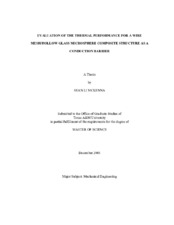| dc.description.abstract | An experimental investigation exploring the use of wire mesh/hollow glass
microsphere combination for use as thermal insulation was conducted with the aim to
conclude whether or not it represents a superior insulation technology to those on the
market.
Three primary variables, including number of wire mesh layers, filler material,
and temperature dependence were studied using an apparatus that was part of
L.I.C.H.E.N (LabVIEW Integrated Conduction Heat Experiment Network), a setup
whose basic components allow three vertically stacked samples to be thermally and
mechanically controlled. Knowing the temperature profile in the upper and lower
samples allows for determination of thermal conductivity of the middle material through
the use of Fourier?s law. The numbers of layers investigated were two, four, six, and
eight, with each separated by a metallic liner. The filler materials included air, s15, s35
and s60HS 3MTM hollow glass microspheres. The experiments were conducted at four
temperatures of 300, 330, 366, and 400K with an interface pressure of 20 Psi. The experimental results indicated the ?number of layers? used was the primary
factor in determining the effective thermal conductivity value. The addition of hollow
glass microspheres as filler material resulted in statistically insignificant changes in
effective thermal conductivity. Increasing the number of wire mesh layers resulted in a
corresponding increase in effective thermal conductivity of the insulation. Changes in
temperature had little to no effect on thermal conductivity.
The effective thermal conductivity values for the proposed insulation structure
ranged from 0.22 to 0.65 W/m-K, the lowest of which came from the two layer case
having air as filler material. The uncertainties associated with the experimental results
fell between 10 to 20 percent in all but a few cases. In the best performing cases, when
compared with existing insulation technologies, thermal conductivity was approximately
3 to 10 times higher than these methods of insulation. Thus, the proposed insulation
scheme with hollow glass-sphere filler material does not represent superior technology,
and would be deemed uncompetitive with those readily available in the insulation
market. | en |


